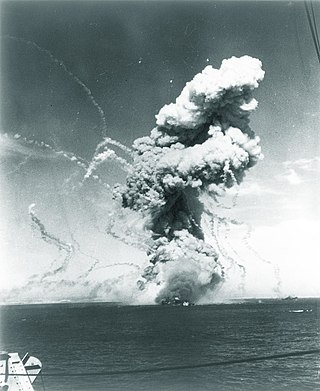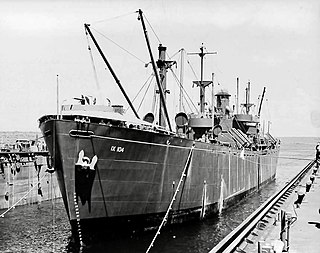
The Victory ship was a class of cargo ship produced in large numbers by North American shipyards during World War II to replace losses caused by German submarines. They were a more modern design compared to the earlier Liberty ship, were slightly larger and had more powerful steam turbine engines, giving higher speed to allow participation in high-speed convoys and make them more difficult targets for German U-boats. A total of 531 Victory ships were built in between 1944 and 1946.

Liberty ships were a class of cargo ship built in the United States during World War II under the Emergency Shipbuilding Program. Although British in concept, the design was adopted by the United States for its simple, low-cost construction. Mass-produced on an unprecedented scale, the Liberty ship came to symbolize U.S. wartime industrial output.

SS Martin Behrman was an American Liberty ship built in 1944 for service in World War II. Her namesake was Martin Behrman, long-time mayor of New Orleans, Louisiana. For the was she was operated by the Isbrandtsen Line under charter with the Maritime Commission and War Shipping Administration.

SS A. Frank Lever was a Liberty ship built in the United States during World War II. Her namesake was A. Francis "Frank" Lever. Her sponsor was Mrs. A. Frank Lever.

California Shipbuilding Corporation built 467 Liberty and Victory ships during World War II, including Haskell-class attack transports. California Shipbuilding Corporation was often referred to as Calship.

SS Timothy Bloodworth was a standard Liberty ship built for the United States Maritime Commission during World War II. The vessel was built by Delta Shipbuilding Company of New Orleans in 1943. She was named in honor of Timothy Bloodworth, an American teacher who made muskets and bayonets during the American Revolutionary War, then went on to become a statesman in North Carolina.
SS V.A. Fogg was a modified T2 tanker built in 1943, as SS Four Lakes. After service in World War II, she was eventually sold into private ownership. She was renamed V.A. Fogg in 1971, shortly before she exploded and sank off Freeport, Texas.

The four Richmond Shipyards, in the city of Richmond, California, United States, were run by Permanente Metals and part of the Kaiser Shipyards. In World War II, Richmond built more ships than any other shipyard, turning out as many as three ships in a single day. The shipyards are part of the Rosie the Riveter/World War II Home Front National Historical Park, whose Rosie the Riveter memorial honors the shipyard workers. Shipyard #3 is listed on the National Register of Historic Places and is a California Historical Landmark # 1032.

The St. Johns River Shipbuilding Company was created in Jacksonville, Florida during World War II to build Liberty ships.

The SS Baton Rouge was a cargo Victory ship built during World War II under the Emergency Shipbuilding program. The Baton Rouge (MCV-846) was a type VC2-S-AP2 Victory ship built by Bethlehem-Fairfield Shipyards. The Maritime Administration cargo ship was the 846rd ship built. Her keel was laid on June 21, 1945. She was launched on August 22, 1945, and completed on September 24, 1945. The 10,600-ton ship was constructed for the Maritime Commission. The American Export Line and later the Isthmian Steamship Company operated her under the United States Merchant Marine act for the War Shipping Administration.

SS Jeremiah M. Daily was a Liberty ship built for the United States Maritime Commission during World War II. The ship was named in honor of Jeremiah M. Daily, (1871-1924) who was the manager of marine department of the San Francisco Chamber of Commerce. Jeremiah M. Daily inspired Jerry Dooley and the Affairs of Cappy Ricks. The ship was assigned by the War Shipping Administration to American South African Line of New York who operated it throughout World War II. Jeremiah M. Daily was laid down on 18 July 1943, launched on 9 August 1943 and completed on 22 August 1943, with the hull No. 1724 as part of the Emergency Shipbuilding Program, built is 35 days.

SS Benjamin Contee was an American Liberty Ship type EC2-S-C1 built in 1942 by the Delta Shipbuilding in New Orleans, Louisiana as part of the Emergency Shipbuilding Program for World War II. She was laid down on February 2, 1942, launched on June 15, 1942, and completed on August 7, 1942. She was operated by the Mississippi Shipping Company for the War Shipping Administration as a United States Merchant Marine ship. She was a Maritime Commission design. Like other Liberty ships, she was 441 feet (134 m) long and 56 feet (17 m) wide, carried 9000 tons of cargo and had a top speed of 11 knots (20 km/h). Most Liberty ships were named after prominent deceased Americans. She was converted from a cargo ship to a troop transport ship. She is named after Benjamin Contee, an American Episcopal priest and statesman from Maryland. He was an officer in the American Revolutionary War, a delegate to the Confederation Congress, and a member of the first United States House of Representatives.

SS Ralph A. Cram was an American Liberty ship built in 1943 for service in World War II. Her namesake was Ralph Adams Cram, an influential American architect of collegiate and ecclesiastical buildings. She was operated by Smith-Johnson Steamship Corporation under charter with the Maritime Commission and War Shipping Administration.

SS Howard A. Kelly was an American Liberty ship built in 1943 for service in World War II. Her namesake was Howard Atwood Kelly, an influential American architect of collegiate and ecclesiastical buildings.

SS Vernon L. Kellogg was an American Liberty ship built in 1943 for service in World War II. Her namesake was Vernon Lyman Kellogg, an American entomologist, evolutionary biologist, and science administrator.

SS Lorrin A. Thurston was a British merchant ship of World War II. A Liberty ship built in the United States in 1943, she was renamed SS Samcalia before completion, and was transferred to the British Ministry of War Transport, with Furness Withy as managers. Sold to her managers after the war, she was renamed SS Pacific Liberty in 1947. Resold in 1954, she passed through several owners, being renamed Phoebus in 1954, Bayhorse in 1963, and San Gabriel in 1970, before being scrapped in 1971. Her original namesake was Lorrin A. Thurston, a Hawaiian-American lawyer, politician, and businessman.

SS Mary Cassatt was an American Liberty ship built in 1943 for service in World War II. Her namesake was Mary Cassatt, an American painter and printmaker.

SS Robert Rowan was an American Liberty ship built in 1943 for service in World War II. Her namesake was Robert Rowan, an American politician.

SS Peter H. Burnett was an American Liberty ship built in 1942 for service in World War II. She was later acquired by the United States Navy and renamed USS P.H. Burnett (IX-104). Her namesake was Peter Hardeman Burnett, an American Governor from 1849 to 1851.

SS M. H. De Young was an American Liberty ship built in 1943 for service in World War II. She was later acquired by the United States Navy and renamed USS Antelope (IX-109). Her namesake was M. H. de Young, an American journalist and businessman from 1865 to 1925.














